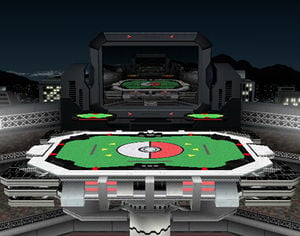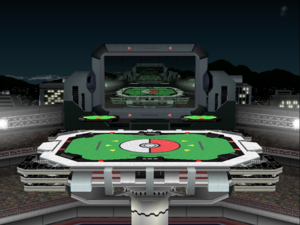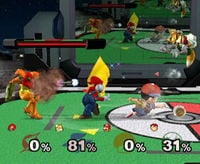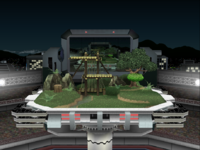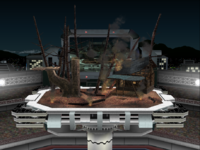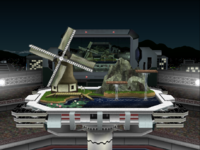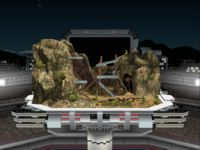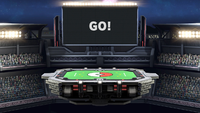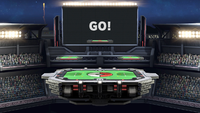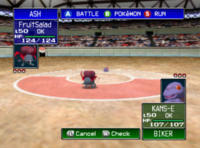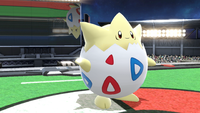Pokémon Stadium: Difference between revisions
No edit summary |
(→Origin: adding this because this seem to be the inspiration for the regular form) Tags: Mobile edit Advanced mobile edit |
||
| (57 intermediate revisions by 37 users not shown) | |||
| Line 1: | Line 1: | ||
{{ArticleIcons|melee=y|brawl=y|ultimate=y}} | {{ArticleIcons|melee=y|brawl=y|ultimate=y}} | ||
''Not to be confused with [[Pokémon Stadium 2]].'' | :''Not to be confused with [[Pokémon Stadium 2]].'' | ||
{{Infobox Stage | {{Infobox Stage | ||
| | |subtitle = ''[[Pokémon]]'' | ||
|name = [[Kanto]]: Pokémon Stadium | |name = [[Kanto]]: Pokémon Stadium | ||
|image = {{tabber|title1=Ultimate| | |image = {{tabber|title1=Ultimate|content1=[[File:SSBU-Pokémon Stadium.png|300px]]|title2=Brawl|content2=[[File:Pokemonstadium.jpg|300px]]|title3=Melee|content3=[[File:PSTAD-NRML1-SSBM.png|300px]]}} | ||
|caption = Pokémon Stadium as it appears in ''Smash''. | |caption = [[File:PokemonSymbol.svg|50px|class=invert]]<br>Pokémon Stadium as it appears in ''Smash''. | ||
|universe = {{uv|Pokémon}} | |universe = {{uv|Pokémon}} | ||
|games = ''[[Melee]]''<br>''[[Brawl]]''<br>''[[Ultimate]]'' | |games = ''[[Melee]]''<br>''[[Brawl]]''<br>''[[Ultimate]]'' | ||
|availability = [[Starter stage|Starter]] (''Melee'' and ''Ultimate'')<br>[[Unlockable stage|Unlockable]] (''Brawl'') | |availability = [[Starter stage|Starter]] (''Melee'' and ''Ultimate'')<br>[[Unlockable stage|Unlockable]] (''Brawl'') | ||
|unlockcriteria = Play on ''[[Pokémon Stadium 2]]'' 10 times in the Brawl Mode. | |unlockcriteria = Play on ''[[Pokémon Stadium 2]]'' 10 times in the Brawl Mode. | ||
| Line 16: | Line 15: | ||
|brawlmusic = ''{{SSBBMusicLink|Super Smash Bros.|Pokémon Stadium (Melee)}}''<br>'''''{{SSBBMusicLink|Super Smash Bros.|Battle Theme (Melee)}}'''''<br>'''''{{SSBBMusicLink|Super Smash Bros.|Poké Floats (Melee)}}''''' | |brawlmusic = ''{{SSBBMusicLink|Super Smash Bros.|Pokémon Stadium (Melee)}}''<br>'''''{{SSBBMusicLink|Super Smash Bros.|Battle Theme (Melee)}}'''''<br>'''''{{SSBBMusicLink|Super Smash Bros.|Poké Floats (Melee)}}''''' | ||
|ultimatemusic = [[List of SSBU Music (Pokémon series)|''Pokémon'' series music]]<br>Main: ''{{SSBUMusicLink|Pokémon|Main Theme - Pokémon Red & Blue (Melee)}}''<br>Alternate: ''{{SSBUMusicLink|Pokémon|Pokémon Gold / Pokémon Silver Medley}}'' | |ultimatemusic = [[List of SSBU Music (Pokémon series)|''Pokémon'' series music]]<br>Main: ''{{SSBUMusicLink|Pokémon|Main Theme - Pokémon Red & Blue (Melee)}}''<br>Alternate: ''{{SSBUMusicLink|Pokémon|Pokémon Gold / Pokémon Silver Medley}}'' | ||
|meleesingles = Counterpick | |meleesingles = Starter/Counterpick | ||
|meleedoubles = Starter | |meleedoubles = Starter | ||
|brawlsingles = Starter/Counterpick | |brawlsingles = Starter/Counterpick | ||
| Line 27: | Line 26: | ||
}} | }} | ||
{{cquote|''After ten years, it's back! In addition to the basic stadium formation, the stage also switches between Fire, Water, Rock, and Grass variations. If you want to win on this stage, you'll have to alter your strategy based on the current formation!''|cite=[https://www.smashbros.com/en_US/blog/ Super Smash Blog]|source=[[Super Smash Bros. Ultimate Official Site]]}} | {{cquote|''After ten years, it's back! In addition to the basic stadium formation, the stage also switches between Fire, Water, Rock, and Grass variations. If you want to win on this stage, you'll have to alter your strategy based on the current formation!''|cite=[https://www.smashbros.com/en_US/blog/ Super Smash Blog]|source=[[Super Smash Bros. Ultimate Official Site]]}} | ||
Announced at [[E3]] 2001, '''Pokémon Stadium''' ({{ja|ポケモンスタジアム|Pokemon Sutajiamu}}, ''Pokémon Stadium''), is a stage debuting in ''[[Super Smash Bros. Melee]]'' and returning in both ''[[Super Smash Bros. Brawl]]'' and ''[[Super Smash Bros. Ultimate]]''. It is commonly referred to as "Pokémon Stadium 1" to | Announced at [[E3]] 2001, '''Pokémon Stadium''' ({{ja|ポケモンスタジアム|Pokemon Sutajiamu}}, ''Pokémon Stadium''), is a stage debuting in ''[[Super Smash Bros. Melee]]'' and returning in both ''[[Super Smash Bros. Brawl]]'' and ''[[Super Smash Bros. Ultimate]]''. It is commonly referred to as '''"Pokémon Stadium 1"''' to avoid confusion with its similar successor, [[Pokémon Stadium 2]]. | ||
In ''Melee''{{'}}s [[All-Star Mode]], this stage is played on when the player faces {{SSBM|Pikachu}} and any of its teammates. | In ''Melee''{{'}}s [[All-Star Mode]], this stage is played on when the player faces {{SSBM|Pikachu}} and any of its teammates. | ||
In ''Melee'', Pichu and Jigglypuff are fought here for their character unlock battles; in ''Ultimate'', Pokémon Trainer is fought here for | In ''Melee'', Pichu and Jigglypuff are fought here for their character unlock battles; in ''Ultimate'', Pokémon Trainer is fought here for his character unlock battle. | ||
In ''Ultimate'', the jumbotron has a wider screen just like [[Pokémon Stadium 2]]. | |||
==Stage overview== | ==Stage overview== | ||
| Line 38: | Line 39: | ||
The basic stage is symmetrical and consists of one large main platform, with two floating [[soft platform]]s above. After a varying period of time, the basic stage transforms into a random one of four variants, each based on a {{iw|bulbapedia|type}} from the ''Pokémon'' series. After a while, the stage reverts to the basic form, and the cycle repeats. The same variant can occur consecutively. All forms have an impassable vertical pillar underneath the main platform. | The basic stage is symmetrical and consists of one large main platform, with two floating [[soft platform]]s above. After a varying period of time, the basic stage transforms into a random one of four variants, each based on a {{iw|bulbapedia|type}} from the ''Pokémon'' series. After a while, the stage reverts to the basic form, and the cycle repeats. The same variant can occur consecutively. All forms have an impassable vertical pillar underneath the main platform. | ||
In the background, | In the background, a large crowd watches the fight while fireworks go off in the sky. There is a large jumbotron which can display the battle itself, a symbol representing the upcoming variation during a stage transition, or the current standings of fighters and the [[match timer]]. In ''Brawl'', the jumbotron in the background shows the fight in a lower picture definition than in ''Melee'', and uses a new, clearer font for its display. When the jumbotron displays the "Current Leader" in ''Melee'' and ''Ultimate'', the font of the character's names matches that color of their player port. Additionally, in [[Team Battle]]s, the color of the CPU players' names matches their respective teams color but with less saturation. In ''Brawl'' it will show only one character's name even if there's currently a tie between multiple characters for the highest score/stock count, and in [[Team Battle]]s, will only display the character leading the team with the higher score rather than the entire winning team. When playing on this stage in [[Training Mode]] in ''Melee'', the stage will not transform and the jumbotron only focuses on the battle or zooms in on one of the characters. | ||
{{clrl}} | {{clrl}} | ||
| Line 57: | Line 58: | ||
The '''{{iw|bulbapedia|Water|type}}''' variant takes place near a pond or lake. The whole right side is occupied by a flat pond, while on the left there is a small elevated pier which slopes down on both its sides. Over the pond, two soft platforms are suspended by water spouts, the right one higher than the left one. | The '''{{iw|bulbapedia|Water|type}}''' variant takes place near a pond or lake. The whole right side is occupied by a flat pond, while on the left there is a small elevated pier which slopes down on both its sides. Over the pond, two soft platforms are suspended by water spouts, the right one higher than the left one. | ||
On the left side there is a windmill. Its arms spin slowly and can be stood upon, but players on the current lowest arm fall. The arms are soft in ''Melee'' but hard in ''Brawl''. | On the left side there is a windmill. Its arms spin slowly and can be stood upon, but players on the current lowest arm fall. The arms are soft in ''Melee'' and ''Ultimate'' but hard in ''Brawl''. In ''Brawl'' it's possible for small items to get stuck in the windmill if one lands in the center of the windmill just as it becomes solid. [[Poké Ball]]s will not activate while stuck there. | ||
{{clrl}} | {{clrl}} | ||
| Line 66: | Line 67: | ||
The left side is occupied by a large solid mountain, on whose right side stem two more soft platforms. The walls it creates can cause [[infinite]]s and [[cave of life|caves of life]]. The top of the mountain itself acts as a solid platform. The mountain's left side is almost vertical and ends almost at the right edge of the stage, leaving a small walkable space. | The left side is occupied by a large solid mountain, on whose right side stem two more soft platforms. The walls it creates can cause [[infinite]]s and [[cave of life|caves of life]]. The top of the mountain itself acts as a solid platform. The mountain's left side is almost vertical and ends almost at the right edge of the stage, leaving a small walkable space. | ||
{{clrl}} | {{clrl}} | ||
===Ω form and Battlefield form=== | ===Ω form and Battlefield form=== | ||
In ''Super Smash Bros. Ultimate'', the [[Ω form]] and [[Battlefield form]] are set on the default transformation of the regular form and does not transform into any of the four variants. The main platform is also resized and reshaped to match {{SSBU|Final Destination}} and {{SSBU|Battlefield}}, respectively. The three [[soft platform]]s of the Battlefield form are based on the ones in the normal form. | In ''Super Smash Bros. Ultimate'', the [[Ω form]] and [[Battlefield form]] are set on the default transformation of the regular form and does not transform into any of the four variants. The soft platforms are also absent. The main platform is also resized and reshaped to match {{SSBU|Final Destination}} and {{SSBU|Battlefield}}, respectively. The three [[soft platform]]s of the Battlefield form are based on the ones in the normal form. | ||
<gallery widths="200px"> | <gallery widths="200px"> | ||
SSBU-Pokémon StadiumOmega.png|Ω form in ''Super Smash Bros. Ultimate''. | SSBU-Pokémon StadiumOmega.png|Ω form in ''Super Smash Bros. Ultimate''. | ||
| Line 86: | Line 81: | ||
==Origin== | ==Origin== | ||
[[File:PokemonStadiumN64.png|thumb|left|A battle in the game ''Pokémon Stadium'', notably including the Poké Ball logo in the middle and a crowd watching the battle.]] | [[File:PokemonStadiumN64.png|thumb|left|A battle in the game ''Pokémon Stadium'', notably including the Poké Ball logo in the middle and a crowd watching the battle.]] | ||
While the stage is not specifically based on anything from the | While the stage is not specifically based on anything from the {{uv|Pokémon}} video game series, it may be a general representation of a {{s|bulbapedia|Gym}}. A possible specific origin could be the ''[[bulbapedia:Pokémon Stadium series|Pokémon Stadium]]'' games, from which the stage's name possibly comes from and whose arenas in-game feature a [[Poké Ball]] logo in the middle, a crowd watching the battle and, in the case of Gym Leader battles, type-related aesthetics. However, the arenas in the ''Pokémon Stadium'' games, including the type-themed ones, do not affect the battles in any way. Despite sharing its name with the game ''{{iw|bulbapedia|Pokémon Stadium|English}}'', the stage features no direct references to it or [[bulbapedia:Pokémon Stadium 2|its sequel]]. | ||
Another possible source is the ''{{iw|bulbapedia|Pokémon|anime}}'' anime, in which, during tournament battles, the arena changes its terrain frequently to hinder or help either Pokémon. This was seen at least in the preliminary rounds of the {{s|bulbapedia|Indigo League}}, during which each of {{s|bulbapedia|Ash Ketchum}}'s four initial battles was in a different battlefield representing a specific elemental type. | |||
<gallery> | |||
Indigo Plateau Conference Grass Field.png| The Grass Field in the ''anime''. | |||
Indigo Plateau Conference Rock Field.png|The Rock Field in the ''anime''. | |||
</gallery> | |||
{{clr}} | {{clr}} | ||
==Tournament legality== | ==Tournament legality== | ||
===''Melee''=== | ===''Melee''=== | ||
Pokémon Stadium was one of the few stages that people in tournaments have almost never questioned being legal, and for a long time, was a starter. Many people considered Pokémon Stadium to be one of the fairest stages in '' | Pokémon Stadium was one of the few stages that people in tournaments have almost never questioned being legal, and for a long time, was a starter. Many people considered Pokémon Stadium to be one of the fairest stages in ''Melee'' because the shifting terrain was generally not very disruptive to gameplay, and for some time, was thought to prevent excessive projectile [[camping]]. However, recent metagame developments have shown that {{SSBM|Fox}} and {{SSBM|Falco}} have a very large advantage on this stage because the geometry of the stage and terrain allow them to projectile camp with [[Blaster]] very safely. It is also the only legal stage with walls, allowing Fox to perform the [[drill shine infinite]]. The large horizontal size of the stage benefits their movement greatly, while hindering other characters who cannot traverse across the stage as easily, while the low ceiling allows even earlier KOs for Fox's two main finishers. The transformations also benefit Falco, and especially Fox, greatly in several matchups by either giving them more room to approach or safe spots to camp in. | ||
While the long stage size, platform placement of the main stage, and low ceiling can also benefit characters with good [[dash dance]]s such as {{SSBM|Marth}} and {{SSBM|Captain Falcon}}, the advantages that these characters gain pale in comparison to the aforementioned advantages realized by Fox and Falco. As such, it has been deemed a counterpick stage in more recent rulesets, with some ''Melee'' players arguing that it should even be banned because the advantages given to those two characters are | While the long stage size, platform placement of the main stage, and low ceiling can also benefit characters with good [[dash dance]]s such as {{SSBM|Marth}} and {{SSBM|Captain Falcon}}, the advantages that these characters gain pale in comparison to the aforementioned advantages realized by Fox and Falco. As such, it has been deemed a counterpick stage in more recent rulesets, with some ''Melee'' players arguing that it should even be banned because the advantages given to those two characters are too overwhelming for the majority of the cast. Many players will choose to "wait out" the Fire and Rock transformations by moving to the opposite side of the stage as their opponent, without approaching or attacking them, until the transformation returns to neutral. As a result, many players complain that the transformations result in several minutes of wasted time during a set. | ||
"Frozen Stadium", a modded version of Pokémon Stadium which disables the stage transformations, has become increasingly popular in competitive play. It was first used sporadically in regional scenes, such as at {{Trn|Battle of BC 3}}, and became more widespread following the dominance of online play in 2020, as the [[Project Slippi]] netplay system uses Frozen Stadium as a default stage in unranked play. Frozen Stadium has now become widespread in offline tournaments, but is not universal, as a few tournaments, such as {{Trn|The Big House 10}}, have kept the unfrozen version. Supporters of Frozen Stadium argue that the removal of transformations makes the stage less randomized, more balanced, and removes the time wasting components often seen during the Fire and Rock stages. Opponents of Frozen Stadium argue that this would open up a path towards increased levels of modding and possibly the introduction of new player-built stages, making it more difficult to run in tournaments and possibly leading to legal issues with [[Nintendo]]. They also argue that stalling during the transformations should be seen as a viable counterpicking strategy, and that Frozen Stadium's layout is too similar to that of {{SSBM|Final Destination}}, further hurting characters who have a perceived disadvantage on both stages. | |||
===''Brawl''=== | ===''Brawl''=== | ||
The stage is more debatable in its neutrality; while it is a starter in the Unity Ruleset and always in seven-stage starter lists, [[Lylat Cruise]] is often chosen over it in five-stage starter lists, while never being a starter in three-stage starter lists. The change in unquestioned neutrality comes from changes to the stage itself: first, the lips at the edges of the stage are much more thin and deceptive, occasionally flustering recoveries from slightly underneath the stage or even regular recoveries away from the stage. The most notable change in the stage, however, comes from the redesigned water transformation: while it looks almost the same as in ''Melee'', the blades of the windmill are no longer soft [[platform]]s and cannot be passed through in any direction, resulting in stage traversal difficulties and significant [[caves of life]]. | The stage is more debatable in its neutrality; while it is a starter in the Unity Ruleset and always in seven-stage starter lists, [[Lylat Cruise]] is often chosen over it in five-stage starter lists, while never being a starter in three-stage starter lists. The change in unquestioned neutrality comes from changes to the stage itself: first, the lips at the edges of the stage are much more thin and deceptive, occasionally flustering recoveries from slightly underneath the stage or even regular recoveries away from the stage. The most notable change in the stage, however, comes from the redesigned water transformation: while it looks almost the same as in ''Melee'', the blades of the windmill are no longer soft [[platform]]s and cannot be passed through in any direction, resulting in stage traversal difficulties and significant [[caves of life]]. Like in ''Melee'', ''Brawl'' players tend to camp out the Rock and Fire transformations, hiding behind the large rock and the tree until the transformation has ended, slowing down gameplay and matches. | ||
===''Ultimate''=== | ===''Ultimate''=== | ||
The stage is usually banned, as it has too many similarities to Pokémon Stadium 2 when hazards are turned off. Some regions, however, have Pokémon Stadium as a legal starter over Pokémon Stadium 2, most notably Chicago and | The stage is usually banned, as it has too many similarities to Pokémon Stadium 2 when hazards are turned off. Some regions, however, have Pokémon Stadium as a legal starter over Pokémon Stadium 2, most notably Chicago and, at one point, [[Maryland/Virginia]]. This is mainly due to some players believing the stage is a more reasonable size when compared to Pokémon Stadium 2. Opponents of this stage, on the other hand, cite several inconsistencies that make the stage more "janky" and therefore ill-suited for competitive play compared to its successor; most notably, the stage suffers from bugs that can cause players to clip inside the main platform of the stage, and prior to version {{SSBU|12.0.0}}, the right platform featured an invisible slant that made it impossible to perform [[lock]]s over it. The stage's camera also causes the visibility of the edges to be obstructed. | ||
With the release of [[Small Battlefield]], Pokémon Stadium generally fell even more out of favor, as Small Battlefield could provide a significantly more compact alternative to Pokémon Stadium 2, and the need of a middle ground was not felt much by most of the community. As a result of all these factors, Pokémon Stadium is currently banned in almost every region worldwide. | |||
==Trophy== | ==Trophy== | ||
{{Trophy | |||
|name=Pokémon Stadium | |||
|image=Pokémon Stadium Trophy Melee.png | |||
|desc=[[Pokémon trainer|Trainers]] come from far and wide to congregate at Pokémon Stadiums, the ultimate venues to show off their Pokémon teams. There are many different arenas with varying terrain designs, some of which afford advantages to certain Pokémon. This particular stadium is reserved for huge events and boasts a big screen and spectacular fireworks. | |||
|gamelist={{Trophy games|game1=Pokémon Stadium|release1=3/00}} | |||
|game=Melee | |||
}} | |||
{{clrl}} | {{clrl}} | ||
| Line 116: | Line 122: | ||
===''Super Smash Bros. Brawl''=== | ===''Super Smash Bros. Brawl''=== | ||
*On the | *On the grass variant stage, if a character walks onto the very left where the tree stump is while it is forming, they will fall through. | ||
==Gallery== | ==Gallery== | ||
===''Super Smash Bros. Melee''=== | ===''Super Smash Bros. Melee''=== | ||
<gallery> | <gallery> | ||
Pokemon Stadium Beta.png|A pre-release image for ''Melee'' showing that the icons on the Jumbotron | Pokemon Stadium Beta.png|A pre-release image for ''Melee'' showing that the icons on the Jumbotron were originally meant to be the type symbols from the Pokémon TCG. | ||
</gallery> | </gallery> | ||
| Line 136: | Line 142: | ||
SSBUWebsiteKingDedede3.jpg|{{SSBU|King Dedede}} with a [[Poké Ball]] after performing his forward smash on the stage. | SSBUWebsiteKingDedede3.jpg|{{SSBU|King Dedede}} with a [[Poké Ball]] after performing his forward smash on the stage. | ||
SSBUWebsiteKlaptrap2.jpg|{{SSBU|Roy}} being bitten by a [[Klaptrap]] on the stage. | SSBUWebsiteKlaptrap2.jpg|{{SSBU|Roy}} being bitten by a [[Klaptrap]] on the stage. | ||
PokémonStadiumUltimateJumbotron.jpg|The stadium's jumbotron, showing the stage layout and the fighters competing in the match. | |||
PokémonStadiumUltimateJumbotron.jpg|The stadium's jumbotron. | |||
</gallery> | </gallery> | ||
==Names in other languages== | |||
{{langtable | |||
|ja={{ja|ポケモンスタジアム|Pokemon Sutajiamu}}, ''Pokémon Stadium'' | |||
|jaM=Pokémon Stadium | |||
|en=Pokémon Stadium | |||
|fr=Stade Pokémon | |||
|frM=Pokémon Stadium | |||
|es=Estadio Pokémon | |||
|esM=Pokémon Stadium | |||
|de=Pokémon Stadium | |||
|it=Lo Stadio Pokémon | |||
|itM=Pokémon Stadium | |||
|nl=Pokémon Stadium | |||
|ru={{rollover|Стадион Покемонов|Stadion Pokemonov|?}} | |||
|ruM=Pokémon Stadium | |||
|ko={{rollover|포켓몬 스타디움|Pokenmon Seutadium|?}} | |||
|koM=Pokémon Stadium | |||
|zh=Pokémon Stadium | |||
}} | |||
==Trivia== | ==Trivia== | ||
*The icons flashing on the jumbotron, which denote the arena types, are derived from the type symbols of the {{s|bulbapedia|Trading Card Game}}, and in an early version of ''Melee'', they looked exactly the same. | *The icons flashing on the jumbotron, which denote the arena types, are derived from the type symbols of the {{s|bulbapedia|Trading Card Game}}, and in an early version of ''Melee'', they looked exactly the same. | ||
**The icon that flashes when the stage is about to change into its Water form is the tidal wave from Japanese painter {{s|wikipedia|Hokusai}}'s famous painting, ''{{s|wikipedia|The Great Wave off Kanagawa}}''. | **The icon that flashes when the stage is about to change into its Water form is the tidal wave from Japanese painter {{s|wikipedia|Hokusai}}'s famous painting, ''{{s|wikipedia|The Great Wave off Kanagawa}}''. | ||
*Since the jumbotron takes up a large part of the stage, whenever it displays the match, the images on the jumbotron are replicated inside the projected jumbotron and so on, creating a {{s|wikipedia|Droste effect}}. | *Since the jumbotron takes up a large part of the stage, whenever it displays the match, the images on the jumbotron are replicated inside the projected jumbotron and so on, creating a {{s|wikipedia|Droste effect}}. | ||
*When a player opens up the menu in Training Mode, the jumbotron will follow the game camera's zoom in on their character. | *When a player opens up the menu in Training Mode, the jumbotron will follow the game camera's zoom in on their character. | ||
*This is the only ''Pokémon'' stage to not feature any Pokémon in any capacity. | *This is the only ''Pokémon'' stage to not feature any [[List of Pokémon|Pokémon]] in any capacity. | ||
* | **However, many Pokémon including [[Venusaur]] were originally planned to appear on the stage before this idea was scrapped, and Venusaur was instead a [[Poké Ball]] Pokémon in ''Melee''. | ||
[[File:Jumbotron invert PS1 SSBU.png|thumb|The jumbotron image displaying incorrectly.]] | |||
*In ''Ultimate'', if the jumbotron focuses on a character and the game is paused, the jumbotron will try to remain focused on that character if the pause camera is moved around. | |||
**If the pause camera is angled such that the "back" of it is towards the focused character and the camera is zoomed in, the jumbotron's image will be rotated 180 degrees and some of the pixels will be stretched to the edge of the screen. This also occurs on Pokémon Stadium 2. | |||
* | *In ''Brawl'', if {{SSBB|Zero Suit Samus}} is currently on the stage, the jumbotron will display her name as "Samus" instead of "Zero Suit Samus". This also happens in [[Pokémon Stadium 2]] and [[PictoChat]]. | ||
** | |||
*This is the only [[past stage]] in ''Brawl'' to have three music tracks. | *This is the only [[past stage]] in ''Brawl'' to have three music tracks. | ||
* | *In ''Brawl'' whenever either this stage or [[Pokémon Stadium 2]] is featured in an [[event match]], the jumbotron will not display "SUCCESS" when clearing the event, but will display "FAILURE" if the event end in a failure. This was fixed for both stages in the PAL version. | ||
*When playing a game of [[Squad Strike]], the names of the characters on the jumbotron will not change until it updates itself. This also happens on [[Pokémon Stadium 2]]. | *When playing a game of [[Squad Strike]], the names of the characters on the jumbotron will not change until it updates itself. This also happens on [[Pokémon Stadium 2]]. | ||
**This also happens when adding more CPU opponents in [[Training Mode]]. | **This also happens when either adding more CPU opponents in [[Training Mode]] or swapping between {{SSBU|Pyra}} and {{SSBU|Mythra}}. This is unlike ''Melee'' and ''Brawl'' where the jumbotron updated whenever [[Zelda]] and [[Sheik]] transformed or [[Pokémon Trainer]] [[Pokémon Change|changed Pokémon]]. | ||
*In either a [[Stock]] or [[Stamina Mode|Stamina]] match, if a player slot is skipped, the jumbotron sometimes displays the wrong player number if a player loses their last life. For example, in a 3-player Smash involving P2, P3 and P4, if Player 2 gets defeated, the jumbotron displays "Player 1 Defeated" despite player 1 not being present. | *In either a [[Stock]] or [[Stamina Mode|Stamina]] match, if a player slot is skipped, the jumbotron sometimes displays the wrong player number if a player loses their last life. For example, in a 3-player Smash involving P2, P3 and P4, if Player 2 gets defeated, the jumbotron displays "Player 1 Defeated" despite player 1 not being present. | ||
*On the left side of the background, a building with the word "POCKET" (the O being replaced with a Poké Ball) and a screen can be seen. This is likely based on the Game Boy Tower, a location that acts as a special built-in emulator (which is actually a modified version of the Super Game Boy 2's BIOS) used to play the ''Pokémon'' games inserted into the player's Transfer Pak in ''Pokémon Stadium'' and ''Pokémon Stadium 2''. Additionally, the "POCKET" on the building is a reference to the ''Pokémon'' series' Japanese name, ''Pocket Monsters''. | |||
*The following [[Assist Trophies]] can only appear on the Battlefield and Omega forms of this stage: [[Burrowing Snagret]], [[Kapp'n]], [[Arcade Bunny]] and [[Squid Sisters]]. Additionally, [[Marshadow]] can only be summoned on the stage's Battlefield and Omega forms. | |||
==See also== | ==See also== | ||
| Line 183: | Line 194: | ||
[[Category:Trophies (SSBM)]] | [[Category:Trophies (SSBM)]] | ||
[[Category:Past stages]] | [[Category:Past stages]] | ||
[[es | [[es:Estadio Pokémon]] | ||
Revision as of 08:29, March 18, 2024
- Not to be confused with Pokémon Stadium 2.
| Pokémon Kanto: Pokémon Stadium | |
|---|---|
 Pokémon Stadium as it appears in Smash. | |
| Universe | Pokémon |
| Appears in | Melee Brawl Ultimate |
| Availability | Starter (Melee and Ultimate) Unlockable (Brawl) |
| Unlock criteria | Play on Pokémon Stadium 2 10 times in the Brawl Mode. |
| Crate type | Futuristic (Brawl) Normal (Ultimate) |
| Maximum players | 4 (Melee and Brawl) 8 (Ultimate) |
| Article on Bulbapedia | Pokémon Stadium (stage) |
| “ | After ten years, it's back! In addition to the basic stadium formation, the stage also switches between Fire, Water, Rock, and Grass variations. If you want to win on this stage, you'll have to alter your strategy based on the current formation! | ” |
| —Super Smash Blog, Super Smash Bros. Ultimate Official Site | ||
Announced at E3 2001, Pokémon Stadium (ポケモンスタジアム, Pokémon Stadium), is a stage debuting in Super Smash Bros. Melee and returning in both Super Smash Bros. Brawl and Super Smash Bros. Ultimate. It is commonly referred to as "Pokémon Stadium 1" to avoid confusion with its similar successor, Pokémon Stadium 2.
In Melee's All-Star Mode, this stage is played on when the player faces Pikachu and any of its teammates.
In Melee, Pichu and Jigglypuff are fought here for their character unlock battles; in Ultimate, Pokémon Trainer is fought here for his character unlock battle.
In Ultimate, the jumbotron has a wider screen just like Pokémon Stadium 2.
Stage overview
Basic Version
The basic stage is symmetrical and consists of one large main platform, with two floating soft platforms above. After a varying period of time, the basic stage transforms into a random one of four variants, each based on a type from the Pokémon series. After a while, the stage reverts to the basic form, and the cycle repeats. The same variant can occur consecutively. All forms have an impassable vertical pillar underneath the main platform.
In the background, a large crowd watches the fight while fireworks go off in the sky. There is a large jumbotron which can display the battle itself, a symbol representing the upcoming variation during a stage transition, or the current standings of fighters and the match timer. In Brawl, the jumbotron in the background shows the fight in a lower picture definition than in Melee, and uses a new, clearer font for its display. When the jumbotron displays the "Current Leader" in Melee and Ultimate, the font of the character's names matches that color of their player port. Additionally, in Team Battles, the color of the CPU players' names matches their respective teams color but with less saturation. In Brawl it will show only one character's name even if there's currently a tie between multiple characters for the highest score/stock count, and in Team Battles, will only display the character leading the team with the higher score rather than the entire winning team. When playing on this stage in Training Mode in Melee, the stage will not transform and the jumbotron only focuses on the battle or zooms in on one of the characters.
Grass Version
The Grass variant takes place in some kind of forest or park. The main platform has slightly elevated plateaus on both sides. A small stream separates the left plateau and the central area, causing a slight depression. A wooden structure with two platforms, one above the other, occupies the middle-left part of the stage, while in the right part there is a tree whose branches form a third platform.
Fire Version
The Fire variant takes place in a burning forest. The center of the main platform is occupied by a small depression. On the left side there is a ruined tree: players can stand on top of it, but, due to its height, often need double jumping to reach its top. From the left side of the tree stems a branch which supports a soft floating platform.
On the right side there is a burning shack, the roof of whose porch acts as another soft platform. Note that the fire in the background is purely aesthetic and has no gameplay effect.
Water Version
The Water variant takes place near a pond or lake. The whole right side is occupied by a flat pond, while on the left there is a small elevated pier which slopes down on both its sides. Over the pond, two soft platforms are suspended by water spouts, the right one higher than the left one.
On the left side there is a windmill. Its arms spin slowly and can be stood upon, but players on the current lowest arm fall. The arms are soft in Melee and Ultimate but hard in Brawl. In Brawl it's possible for small items to get stuck in the windmill if one lands in the center of the windmill just as it becomes solid. Poké Balls will not activate while stuck there.
Rock Version
The Rock variant takes place in a canyon near a mine. Its terrain is the most uneven of all versions. The right part is flat and empty, while in the middle there are three soft platforms one above the other, of which the bottom one touches the ground and can be walked up from it.
The left side is occupied by a large solid mountain, on whose right side stem two more soft platforms. The walls it creates can cause infinites and caves of life. The top of the mountain itself acts as a solid platform. The mountain's left side is almost vertical and ends almost at the right edge of the stage, leaving a small walkable space.
Ω form and Battlefield form
In Super Smash Bros. Ultimate, the Ω form and Battlefield form are set on the default transformation of the regular form and does not transform into any of the four variants. The soft platforms are also absent. The main platform is also resized and reshaped to match Final Destination and Battlefield, respectively. The three soft platforms of the Battlefield form are based on the ones in the normal form.
Hazards Off
With hazards off in Ultimate, the stage remains in the Basic Version for the whole match.
Origin
While the stage is not specifically based on anything from the Pokémon video game series, it may be a general representation of a Gym. A possible specific origin could be the Pokémon Stadium games, from which the stage's name possibly comes from and whose arenas in-game feature a Poké Ball logo in the middle, a crowd watching the battle and, in the case of Gym Leader battles, type-related aesthetics. However, the arenas in the Pokémon Stadium games, including the type-themed ones, do not affect the battles in any way. Despite sharing its name with the game Pokémon Stadium, the stage features no direct references to it or its sequel.
Another possible source is the Pokémon anime, in which, during tournament battles, the arena changes its terrain frequently to hinder or help either Pokémon. This was seen at least in the preliminary rounds of the Indigo League, during which each of Ash Ketchum's four initial battles was in a different battlefield representing a specific elemental type.
Tournament legality
Melee
Pokémon Stadium was one of the few stages that people in tournaments have almost never questioned being legal, and for a long time, was a starter. Many people considered Pokémon Stadium to be one of the fairest stages in Melee because the shifting terrain was generally not very disruptive to gameplay, and for some time, was thought to prevent excessive projectile camping. However, recent metagame developments have shown that Fox and Falco have a very large advantage on this stage because the geometry of the stage and terrain allow them to projectile camp with Blaster very safely. It is also the only legal stage with walls, allowing Fox to perform the drill shine infinite. The large horizontal size of the stage benefits their movement greatly, while hindering other characters who cannot traverse across the stage as easily, while the low ceiling allows even earlier KOs for Fox's two main finishers. The transformations also benefit Falco, and especially Fox, greatly in several matchups by either giving them more room to approach or safe spots to camp in.
While the long stage size, platform placement of the main stage, and low ceiling can also benefit characters with good dash dances such as Marth and Captain Falcon, the advantages that these characters gain pale in comparison to the aforementioned advantages realized by Fox and Falco. As such, it has been deemed a counterpick stage in more recent rulesets, with some Melee players arguing that it should even be banned because the advantages given to those two characters are too overwhelming for the majority of the cast. Many players will choose to "wait out" the Fire and Rock transformations by moving to the opposite side of the stage as their opponent, without approaching or attacking them, until the transformation returns to neutral. As a result, many players complain that the transformations result in several minutes of wasted time during a set.
"Frozen Stadium", a modded version of Pokémon Stadium which disables the stage transformations, has become increasingly popular in competitive play. It was first used sporadically in regional scenes, such as at Battle of BC 3, and became more widespread following the dominance of online play in 2020, as the Project Slippi netplay system uses Frozen Stadium as a default stage in unranked play. Frozen Stadium has now become widespread in offline tournaments, but is not universal, as a few tournaments, such as The Big House 10, have kept the unfrozen version. Supporters of Frozen Stadium argue that the removal of transformations makes the stage less randomized, more balanced, and removes the time wasting components often seen during the Fire and Rock stages. Opponents of Frozen Stadium argue that this would open up a path towards increased levels of modding and possibly the introduction of new player-built stages, making it more difficult to run in tournaments and possibly leading to legal issues with Nintendo. They also argue that stalling during the transformations should be seen as a viable counterpicking strategy, and that Frozen Stadium's layout is too similar to that of Final Destination, further hurting characters who have a perceived disadvantage on both stages.
Brawl
The stage is more debatable in its neutrality; while it is a starter in the Unity Ruleset and always in seven-stage starter lists, Lylat Cruise is often chosen over it in five-stage starter lists, while never being a starter in three-stage starter lists. The change in unquestioned neutrality comes from changes to the stage itself: first, the lips at the edges of the stage are much more thin and deceptive, occasionally flustering recoveries from slightly underneath the stage or even regular recoveries away from the stage. The most notable change in the stage, however, comes from the redesigned water transformation: while it looks almost the same as in Melee, the blades of the windmill are no longer soft platforms and cannot be passed through in any direction, resulting in stage traversal difficulties and significant caves of life. Like in Melee, Brawl players tend to camp out the Rock and Fire transformations, hiding behind the large rock and the tree until the transformation has ended, slowing down gameplay and matches.
Ultimate
The stage is usually banned, as it has too many similarities to Pokémon Stadium 2 when hazards are turned off. Some regions, however, have Pokémon Stadium as a legal starter over Pokémon Stadium 2, most notably Chicago and, at one point, Maryland/Virginia. This is mainly due to some players believing the stage is a more reasonable size when compared to Pokémon Stadium 2. Opponents of this stage, on the other hand, cite several inconsistencies that make the stage more "janky" and therefore ill-suited for competitive play compared to its successor; most notably, the stage suffers from bugs that can cause players to clip inside the main platform of the stage, and prior to version 12.0.0, the right platform featured an invisible slant that made it impossible to perform locks over it. The stage's camera also causes the visibility of the edges to be obstructed.
With the release of Small Battlefield, Pokémon Stadium generally fell even more out of favor, as Small Battlefield could provide a significantly more compact alternative to Pokémon Stadium 2, and the need of a middle ground was not felt much by most of the community. As a result of all these factors, Pokémon Stadium is currently banned in almost every region worldwide.
Trophy
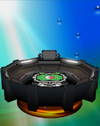
- Pokémon Stadium
- Trainers come from far and wide to congregate at Pokémon Stadiums, the ultimate venues to show off their Pokémon teams. There are many different arenas with varying terrain designs, some of which afford advantages to certain Pokémon. This particular stadium is reserved for huge events and boasts a big screen and spectacular fireworks.
- Pokémon Stadium (3/00)
Glitches
Super Smash Bros. Melee
- On the fire variant, if a character gets hit towards the right side of the tree's base, there's a chance they will fall through.
Super Smash Bros. Brawl
- On the grass variant stage, if a character walks onto the very left where the tree stump is while it is forming, they will fall through.
Gallery
Super Smash Bros. Melee
Super Smash Bros. Brawl
Super Smash Bros. Ultimate
King Dedede with a Poké Ball after performing his forward smash on the stage.
Names in other languages
Trivia
- The icons flashing on the jumbotron, which denote the arena types, are derived from the type symbols of the Trading Card Game, and in an early version of Melee, they looked exactly the same.
- The icon that flashes when the stage is about to change into its Water form is the tidal wave from Japanese painter Hokusai's famous painting, The Great Wave off Kanagawa.
- Since the jumbotron takes up a large part of the stage, whenever it displays the match, the images on the jumbotron are replicated inside the projected jumbotron and so on, creating a Droste effect.
- When a player opens up the menu in Training Mode, the jumbotron will follow the game camera's zoom in on their character.
- This is the only Pokémon stage to not feature any Pokémon in any capacity.
- In Ultimate, if the jumbotron focuses on a character and the game is paused, the jumbotron will try to remain focused on that character if the pause camera is moved around.
- If the pause camera is angled such that the "back" of it is towards the focused character and the camera is zoomed in, the jumbotron's image will be rotated 180 degrees and some of the pixels will be stretched to the edge of the screen. This also occurs on Pokémon Stadium 2.
- In Brawl, if Zero Suit Samus is currently on the stage, the jumbotron will display her name as "Samus" instead of "Zero Suit Samus". This also happens in Pokémon Stadium 2 and PictoChat.
- This is the only past stage in Brawl to have three music tracks.
- In Brawl whenever either this stage or Pokémon Stadium 2 is featured in an event match, the jumbotron will not display "SUCCESS" when clearing the event, but will display "FAILURE" if the event end in a failure. This was fixed for both stages in the PAL version.
- When playing a game of Squad Strike, the names of the characters on the jumbotron will not change until it updates itself. This also happens on Pokémon Stadium 2.
- This also happens when either adding more CPU opponents in Training Mode or swapping between Pyra and Mythra. This is unlike Melee and Brawl where the jumbotron updated whenever Zelda and Sheik transformed or Pokémon Trainer changed Pokémon.
- In either a Stock or Stamina match, if a player slot is skipped, the jumbotron sometimes displays the wrong player number if a player loses their last life. For example, in a 3-player Smash involving P2, P3 and P4, if Player 2 gets defeated, the jumbotron displays "Player 1 Defeated" despite player 1 not being present.
- On the left side of the background, a building with the word "POCKET" (the O being replaced with a Poké Ball) and a screen can be seen. This is likely based on the Game Boy Tower, a location that acts as a special built-in emulator (which is actually a modified version of the Super Game Boy 2's BIOS) used to play the Pokémon games inserted into the player's Transfer Pak in Pokémon Stadium and Pokémon Stadium 2. Additionally, the "POCKET" on the building is a reference to the Pokémon series' Japanese name, Pocket Monsters.
- The following Assist Trophies can only appear on the Battlefield and Omega forms of this stage: Burrowing Snagret, Kapp'n, Arcade Bunny and Squid Sisters. Additionally, Marshadow can only be summoned on the stage's Battlefield and Omega forms.
See also
| Stages in Super Smash Bros. Melee | |
|---|---|
| Starter stages | Brinstar · Corneria · Fountain of Dreams · Great Bay · Green Greens · Icicle Mountain · Jungle Japes · Kongo Jungle · Mushroom Kingdom · Mute City · Onett · Pokémon Stadium · Princess Peach's Castle · Rainbow Cruise · Temple · Venom · Yoshi's Island · Yoshi's Story |
| Unlockable stages | Battlefield · Big Blue · Brinstar Depths · Final Destination · Flat Zone · Fourside · Mushroom Kingdom II · Poké Floats |
| Dream Land · Kongo Jungle · Yoshi's Island | |

